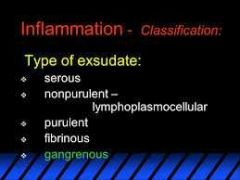![]()
![]()
![]()
Use LEFT and RIGHT arrow keys to navigate between flashcards;
Use UP and DOWN arrow keys to flip the card;
H to show hint;
A reads text to speech;
3 Cards in this Set
- Front
- Back
|
Macroscopic findings in inflammation (Cardinal signs) |
1. Rubor (redness) - due to small vasculature dilation 2. Calor (heat) - due to increased blood flow (hyperemia) to the target region. Fever is due to IL1 and TNF (acting on hypothalamus raising the temperature setpoin)t, PGE2, and bradykinin 3. Tumor (swelling) - fluid exudation and accumulation in interstitium 4. Dolor (pain) - trauma, stretching due to edema or pus, PGE2, bradykinin, and serotonin 5. Functio laesa (loss of function) - due to pain and swelling |
|
|
Laboratory signs of inflammation |
1. Elevated white blood cell count 2. Elevated erythrocyte sedimentation rate (ESR) 3. Elevated level of positive acute phase reactants (APRs) -eg. CRP, SAA, ceruloplasmin, haptoglobin, etc. 4. Reduced level of negative APRs -eg. albumin |
|
|
Classification of inflammation |

|

